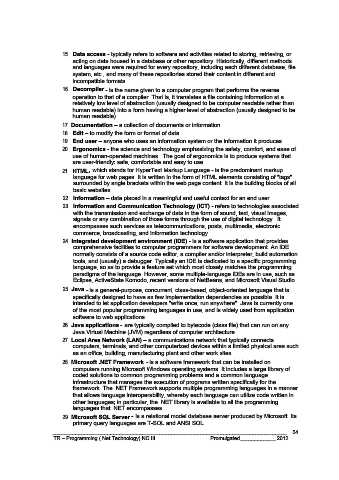Page 249 - aREA ix eXHIBITS
P. 249
15. Data access - typically refers to software and activities related to storing, retrieving, or
acting on data housed in a database or other repository. Historically, different methods
and languages were required for every repository, including each different database, file
system, etc., and many of these repositories stored their content in different and
incompatible formats.
16. Decompiler - is the name given to a computer program that performs the reverse
operation to that of a compiler. That is, it translates a file containing information at a
relatively low level of abstraction (usually designed to be computer readable rather than
human readable) into a form having a higher level of abstraction (usually designed to be
human readable)
17. Documentation – a collection of documents or information.
18. Edit – to modify the form or format of data
19. End user – anyone who uses an information system or the information it produces.
20. Ergonomics - the science and technology emphasizing the safety, comfort, and ease of
use of human-operated machines. The goal of ergonomics is to produce systems that
are user-friendly: safe, comfortable and easy to use.
21. HTML, which stands for HyperText Markup Language - is the predominant markup
language for web pages. It is written in the form of HTML elements consisting of "tags"
surrounded by angle brackets within the web page content. It is the building blocks of all
basic websites.
22. Information – data placed in a meaningful and useful context for an end user.
23. Information and Communication Technology (ICT) - refers to technologies associated
with the transmission and exchange of data in the form of sound, text, visual images,
signals or any combination of those forms through the use of digital technology. It
encompasses such services as telecommunications, posts, multimedia, electronic
commerce, broadcasting, and information technology.
24. Integrated development environment (IDE) - is a software application that provides
comprehensive facilities to computer programmers for software development. An IDE
normally consists of a source code editor, a compiler and/or interpreter, build automation
tools, and (usually) a debugger. Typically an IDE is dedicated to a specific programming
language, so as to provide a feature set which most closely matches the programming
paradigms of the language. However, some multiple-language IDEs are in use, such as
Eclipse, ActiveState Komodo, recent versions of NetBeans, and Microsoft Visual Studio.
25. Java - is a general-purpose, concurrent, class-based, object-oriented language that is
specifically designed to have as few implementation dependencies as possible. It is
intended to let application developers "write once, run anywhere". Java is currently one
of the most popular programming languages in use, and is widely used from application
software to web applications
26. Java applications - are typically compiled to bytecode (class file) that can run on any
Java Virtual Machine (JVM) regardless of computer architecture.
27. Local Area Network (LAN) – a communications network that typically connects
computers, terminals, and other computerized devices within a limited physical area such
as an office, building, manufacturing plant and other work sites.
28. Microsoft .NET Framework - is a software framework that can be installed on
computers running Microsoft Windows operating systems. It includes a large library of
coded solutions to common programming problems and a common language
infrastructure that manages the execution of programs written specifically for the
framework. The .NET Framework supports multiple programming languages in a manner
that allows language interoperability, whereby each language can utilize code written in
other languages; in particular, the .NET library is available to all the programming
languages that .NET encompasses.
29. Microsoft SQL Server - is a relational model database server produced by Microsoft. Its
primary query languages are T-SQL and ANSI SQL
_________________________________________________________________________________ 54
TR – Programming (.Net Technology) NC III Promulgated____________ 2013

